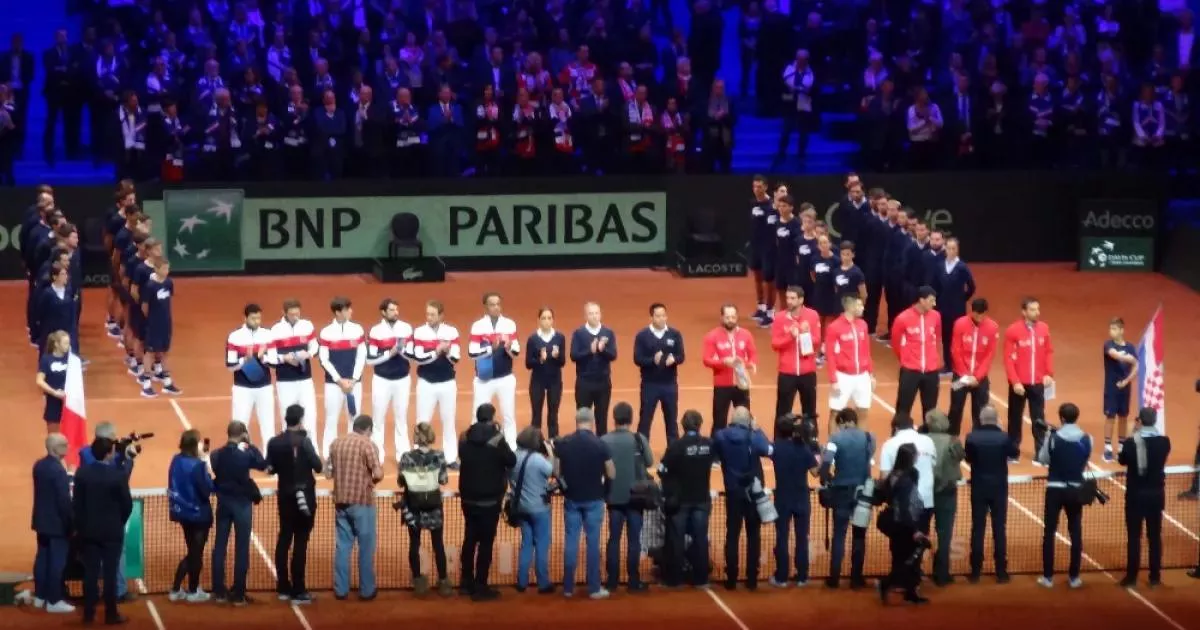The Davis Cup is the leading international team competition in men's tennis, organized by the ITF. It is an annual tournament featuring teams from over 150 countries, making it the world's largest annual team sporting competition. Originating in 1900 as a contest between Great Britain and the United States, it has expanded significantly, with 155 nations participating by 2023. The Davis Cup is often referred to as the 'World Cup of Tennis,' with the winning team being recognized as the world champions.
1900: Competition Began
In 1900, the Davis Cup competition began as a challenge between Great Britain and the United States.
1900: First Match Held
In 1900, the first Davis Cup match was held between the United States and Britain in Boston, with the US winning.
1902: US Wins Match
In 1902, the United States won the Davis Cup match against Britain.
1914: Australasia Competes
Until 1914, Australia and New Zealand competed together as a combined team called Australasia.
1923: Zones Split
In 1923, the world's teams were split into two zones: the "America Zone" and the "Europe Zone".
1925: Davis Becomes Secretary of War
In 1925, Davis went on to become a prominent politician in the United States, serving as US Secretary of War.
1929: Davis Becomes Governor-General
In 1929, Davis served as Governor-General of the Philippines.
1932: Davis Ends Term as Governor-General
In 1932, Davis's term as Governor-General of the Philippines ended.
1950: Australia's Domination Begins
From 1950, Australia began to dominate the Davis Cup competition.
1955: Eastern Zone Added
In 1955, a third zone, the "Eastern Zone", was added to the Davis Cup competition.
1956: Rosewall Barred From Davis Cup
Ken Rosewall was barred from playing in the Davis Cup until 1973, since 1956.
1962: Laver Barred From Davis Cup
Rod Laver was barred from playing in the Davis Cup until 1973, since 1962.
1963: Federation Cup Founded
In 1963, the Federation Cup, the women's equivalent of the Davis Cup, was founded. It was later known as Fed Cup and Billie Jean King Cup.
1966: Europe Zone Split
In 1966, the "Europe Zone" was split into two zones, "Europe Zone A" and "Europe Zone B".
1967: Australia's Domination Ends
Australia's domination of the Davis Cup competition ended in 1967.
1968: National Registered Professionals Allowed
From 1968, national registered professional players were allowed to compete in the Davis Cup.
1970: Venue Choice Rule
In case the two countries have not met since 1970, lots are drawn to determine the host country of a Davis Cup tie.
1972: Knockout Competition Format
Beginning in 1972, the Davis Cup format was changed to a knockout competition.
1973: Contract Professionals Allowed
In 1973, all contract professionals were allowed to play in the Davis Cup.
1974: South Africa Awarded Cup
In 1974, South Africa was awarded the Davis Cup after India refused to travel to South Africa in protest of South Africa's apartheid policies.
1981: Tiered System of Competition
From 1981, the Davis Cup used a tiered system of competition.
1989: Relegation Round Renamed
In 1989, the relegation round was renamed to the "World Group Qualifying Round" and expanded. The tiebreak was also introduced into Davis Cup competition in the same year.
1995: Federation Cup Renamed
In 1995, the Federation Cup was renamed to Fed Cup.
2011: Rule Change
Since 2011, if a nation has a winning 3–1 lead after the first reverse single match and that match has gone to four sets or more, then the remaining reverse single match which is a dead rubber is not played.
2016: Tiebreak Introduced
From 2016, the tiebreak is used in all five sets of Davis Cup matches.
2018: Format Change Voted
In 2018, the ITF voted to change the format of the Davis Cup competition from 2019 onwards.
2019: Cup Format Changed
For the 2019 edition, the format of the Davis Cup was changed. The main modification is the World Group taking place at one location and in one week.
January 2023: ITF Takes Back Control
On 12 January 2023, the ITF announced that the partnership with the new promoter ends and that ITF is taking back the control of the Davis Cup event.
2023: 155 Nations Entered
By 2023, 155 nations had entered teams into the Davis Cup competition.
2024: Italy Wins the Davis Cup
In 2024, Italy beat Netherlands to win their third Davis Cup title, their second consecutive one.
Mentioned in this timeline
Ukraine is a large country in Eastern Europe second in...
India officially the Republic of India is a South Asian...
New Zealand is an island country located in the southwestern...

Billie Jean King a former world No American tennis player...
Africa is the second-largest and second-most populous continent comprising of...
Belarus is a landlocked country in Eastern Europe bordered by...
Trending

7 months ago Derrick White Prop Bets Analyzed for Celtics vs Knicks Game 5, May 14, 2025

Michael Lee McDaniel is the head coach of the Miami Dolphins He started his NFL career as an intern for...

8 months ago Payton Pritchard's plan for Celtics bounce-back against Magic, Horford talk, big plays.

24 days ago SpaceX Launches Starlink 6-79 Mission from Cape Canaveral, Continuing Satellite Deployments
18 days ago Volaris Faces Pilot Dispute: ASPA Challenges Foreign Pilot Hiring Amid Route Revocation
20 days ago Delta faces schedule changes due to Oregon pipeline leak, Kotek declares emergency.
Popular

Candace Owens is an American conservative political commentator and author...

Ilhan Omar is an American politician currently serving as the...

XXXTentacion born Jahseh Dwayne Ricardo Onfroy was a controversial yet...

Frederick Christ Trump Sr - was an American real estate...

Oprah Winfrey an American talk show host television producer actress...

Cristiano Ronaldo often nicknamed CR is a Portuguese professional footballer...
